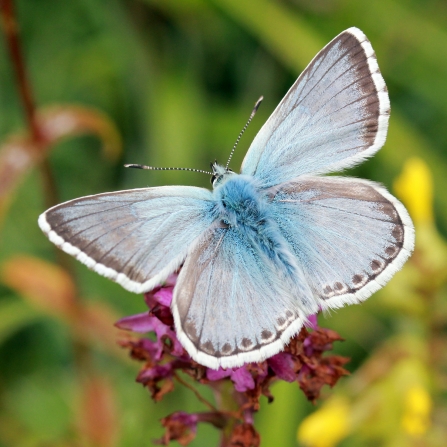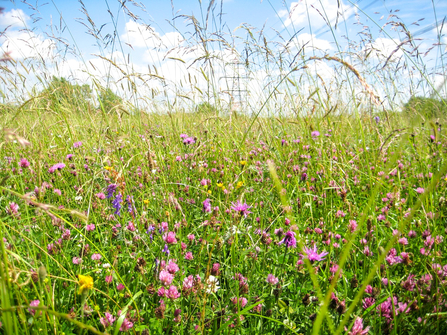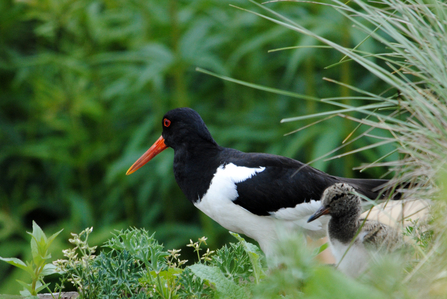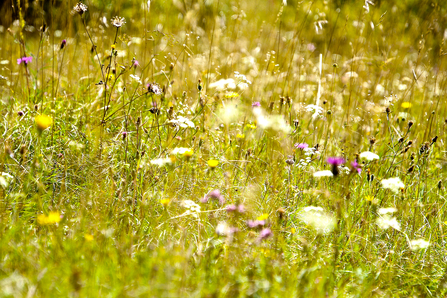
Chalkhill blue by Jim Higham

Chalkhill blue by Jim Higham
Bacombe Hill is noted for its wild orchids and butterflies such as the pyramidal, chalk fragrant and bee orchids and the chalkhill blue butterfly.
You can also enjoy superb views over Wendover and Aylesbury Vale and watch red kites soar overhead from this nature reserve on the Chilterns escarpment.
Join warden Paul Niddler for an introduction to Bacombe Hill reserve on our guided walk on Saturday 15 June.
Discover Bacombe Hill Nature Reserve
Access: Sloping, steep in places, muddy in places. Kissing gates.

Wildflowers in the Coronation Meadow at BBOWT's Chimney Meadows nature reserve. Picture: Wendy Tobitt
June is a wonderful month to visit Chimney Meadows to see the wildflowers meadows at their best. Part of the site is a National Nature Reserve (owned by Natural England), these meadows make up one of England’s largest remaining areas of unspoilt neutral grassland. They were the seed source for the meadows that have been restored elsewhere at Chimney Meadows.
At this time of year, plants such as yellow rattle, common knapweed, oxeye daisy and pepper-saxifrage are beginning to bloom, and later in the summer can be found in abundance.
There is a new observation platform on the banks of the River Thames that gives views out over the National Nature Reserve and Duxford Old River, to the south of the river.
Access: Flat terrain, bumpy underfoot, boggy in winter; bridge and gates. Wellingtons required to cross ford at Great Brook and Duxford, may be impassable if water level is high. Great Brook Road becomes impassable due to flooding, when water levels are very high.
Some paths and the two bird hides are suitable for people with limited mobility. Contact BBOWT for further information on 01367 870904.

The view of the River Thames from BBOWT's Hartslock nature reserve in South Oxfordshire, photographed by Jon Mason, aka TheEarlyBirder
Take a detour from a walk along the Thames Path to visit Hartslock, near Goring-on-Thames, with stunning, far-reaching views. Bee, pyramidal and common spotted-orchids, common twayblade and white helleborine grow on this sloping grassland and long with many other wild flowers.
The reserve is also excellent for insects, featuring a variety of bee species, uncommon shieldbugs, grasshoppers and day-flying moths.
Butterflies include the lovely chalkhill blue, green hairstreak and grizzled skipper. The occasional visit by the rare Adonis blue adds a further splash of colour with the brilliant turquoise-blue of the male butterfly.
There is no parking at the reserve. Please park in the village and walk. The Thames Path National Trail passes close to the site so why not make your visit part of a longer walk.
Access: Steep slopes, firm paths; long flight of steps

Pyramidal orchids by Paul Lane
A sliver of beech woodland and chalk grassland, Hurley Chalk Pit is visited by 15 species of butterfly and is home to wild orchids. The small area of chalk grassland contains many interesting grasses and herbs, such as the elegant quaking-grass and clustered bellflower.
Six different wild orchids have been recorded on the reserve including bee, pyramidal and fragrant orchids. Wild marjoram flourishes on the pit floor, alongside cowslip and wild candytuft.
Access: Gentle slopes but watch out for some loose flint and roots

Oystercatcher and chick. Photo by Amy Lewis
This large, flooded gravel pit has several islands and a ragged, scrubby fringe that skirts around the shallows. The shallows of the lake are perfect feeding areas for wetland birds, while its islands provide quiet spots where common terns and oystercatchers can breed safely away from predators such as foxes. Look out also for nesting wetland birds such as great crested grebe, moorhen and coot.
The scrubby perimeter of the lake is home to blackcaps, whitethroats and other songbirds and bats hunt over the water at dusk.
Access: Flat; partly flooded in winter with muddy, short slopes; gate, boardwalk

Yoesden nature reserve by Jacqui Titcombe
Yoesden is home to an impressive variety of butterflies. It is considered by many as one of the jewels of the Chilterns Area of Outstanding Natural Beauty for the numbers of butterflies found on site. 28 species have been recorded, including three scarce blue species: Adonis, chalkhill and small blue butterflies, all of which rely on the flower-rich grassland that makes up about half of the reserve.
Yoesden is equally important for chalk downland plants. Towards the end of June parts of the bank are pink with amazing shows of common spotted and fragrant orchids laced with the vivid yellow of bird's-foot trefoil, horseshoe vetch and kidney vetch - all plants so important for the butterfly species found here.
Access: Sloping, steep and stony in places, muddy in places; kissing gates and gates; bench